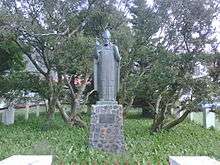Jón Arason
| His Excellency Jan Arason | |
|---|---|
| Bishop of Holar | |
|
Bishop Arason | |
| Church | Roman Catholic |
| Diocese | Hólar |
| Appointed | 22 November 1520 |
| Installed | 1524 |
| Term ended | 7 November 1550 |
| Predecessor | Gottskálk grimmi Nikulásson |
| Successor | Ólafur Hjaltason |
| Orders | |
| Ordination | 1504 |
| Consecration |
1524 by Olav Engelbrektsson |
| Personal details | |
| Born |
1484 Gryta Iceland |
| Died |
7 November 1550 Skalholt Iceland |
| Nationality |
|

Jón Arason (1484 – November 7, 1550) was an Icelandic Roman Catholic bishop and poet, who was executed in his struggle against the imposition of the Protestant Reformation in Iceland. [1]
Background
Jón Arason was born in Gryta, educated at Munkaþverá, the Benedictine abbey of Iceland, and was ordained a Catholic priest about 1504. Having attracted the notice of Gottskálk Nikulásson (1469– 1520), bishop of Hólar, he was sent by that prelate on two missions to Norway. In 1522 he succeeded Gottskálk in the episcopal see of Hólar, but he was soon driven out by the other Icelandic bishop, Ögmundur of Skálholt. Bishop Ögmundur later opposed the imposition of Lutheranism to Iceland, but being old and blind by that time his opposition proved effectively meaningless. [2]
By this point Jón Arason had become known for his great talents if somewhat erratic faith. He fathered numerous children who fought for his causes figuratively and later literally. This was despite the canonical obligation that Catholic bishops are to be celibate, but Iceland was distant enough from Rome for clerical discipline in that age to be very lax. [3]
Struggle with the King
Bishop Jón Arason became involved in a dispute with his sovereign, King Christian III, because of the bishop's refusal to promote Lutheranism on the island. Although initially he took a defensive rather than an offensive position on the matter, this changed radically in 1548. At that point he and Bishop Ögmundur joined their forces to attack the Lutherans. Bishop Ögmundur's contribution did not last, however, due to his infirmities, and he quickly faced exile to Denmark.[4]
Jón Arason's continued resistance is thought to have come from a kind of primitive nationalism and simple ambition as much as religion. He resented the Danes' changing the religious landscape of Iceland and felt their culture would be less disrupted by staying Catholic. Hence he took encouragement from a letter of support from Pope Paul III in continuing his efforts against the Lutheran cause. For the Pope, this seems to have been a generalized opposition to the spread of Protestantism, not necessarily support for the peculiarities of Jon's life or Icelandic culture. Still, the encouragement helped strengthen the opposition against the Lutherans into a kind of civil war.
Jón Arason knew no bounds in his zeal toward that cause, as he fought for what he deemed to be a Catholic Icelandic, in a personal struggle against the Danes. In this struggle he had the help of his illegitimate children, who fought with him in various battles. However his attempt to capture his greatest adversary, Daði Gudmundsson, at the Battle of Sauðafell led to himself being taken prisoner and handed over to the king's bailiff. Legend states that, on hearing this, one of his feistier daughters rallied her forces to save him, but even if this is so her efforts proved unsuccessful. In 1550 Jón Arason and two of his sons, Ari and Björn, were captured and beheaded. Christian Skriver, the king's bailiff, would later be killed by fishermen who favored Jón's cause.
Legacy

Legends claim that as he was about to be beheaded, a priest called Sveinn was by his side to offer him comfort. Sveinn told Jón: Líf er eftir þetta, herra! ("There is a life after this one, Sire!") Jón turned to Sveinn and said: Veit ég það, Sveinki! ("That I know, little Sveinn!") Ever since veit ég það, Sveinki has been a part of the Icelandic treasury of sayings, in this case meaning that something totally obvious has been stated.[5]
Gunnar Gunnarsson wrote Jón Arason (Copenhagen: Gyldendal, 1930), a fictionalized account of the life of Jón. Originally written in Danish, the book has been translated into other languages including English.
Notes
- This article incorporates text from the 1913 Catholic Encyclopedia article "Arason Jón" by E.A. Wang, a publication now in the public domain.
 This article incorporates text from a publication now in the public domain: Chisholm, Hugh, ed. (1911). "Arason, Jon". Encyclopædia Britannica. 2 (11th ed.). Cambridge University Press. p. 320.
This article incorporates text from a publication now in the public domain: Chisholm, Hugh, ed. (1911). "Arason, Jon". Encyclopædia Britannica. 2 (11th ed.). Cambridge University Press. p. 320.
References
- ↑ "Kórkápa Jóns biskups Arasonar". Þjóðminjasafn Íslands. Retrieved October 11, 2015.
- ↑ "Aftaka Jóns biskups Arasonar og atburðir á Suðurnesjum Hólafeðgar hálsgöggnir". Ferlir.is. Retrieved October 11, 2015.
- ↑ "Jón Arason - The reformation". The Saga Museum. Retrieved October 31, 2015.
- ↑ "Jón Arason í vitund Íslendinga". Ýmsir höfundar. Retrieved October 11, 2015.
- ↑ "The Beheading of Jón Arason". icelandic roots. Retrieved 2016-04-30.
External links
- Söguþættir og ættartölur Jóns biskups Arasonar á Hólum Primary sources on Jón's life
- Jón Arason biskup og ætt hans: A concise, Icelandic overview of his life and main poetic works, the main biographies as well as the main novels etc. based on his life, and his ancestry
